Since I was a kid, my extended family has gathered for a week every summer to camp at the beach in Carpinteria. Just below Santa Barbara, Carpinteria is on the north end of Southern California, at least the way I draw the lines. I think of Southern California as being everything below Point Conception (that’s the elbow one-third of the way up the state’s coastline).
I currently live near the south end of Southern California in San Diego County. But more to the point, I’m inland: twenty miles away from the ocean, and in the foothills at an elevation of about 1,500 feet in an area called Ramona.
In essence, the climates in Carpinteria and my place are about as different as you’ll find within the region of Southern California.
So I look forward to my summer week in Carp because I get a break from the heat, but also because I get to browse the neighborhoods and observe gardens, and over the past handful of years I’ve been paying a visit to the new Carpinteria Community Garden. I always learn things on my visits.
Powdery mildew
The community garden is located only a couple blocks from the water. When my vegetables in Ramona are getting full sun from 6 AM, the vegetables in Carp are still under the marine layer of fog, often until lunchtime, sometimes all day long. Summer fog makes powdery mildew happy. This year the PM is especially prevalent in the garden. It’s all over beans, kale, zucchini, cucumbers, pumpkins, and tomatoes.
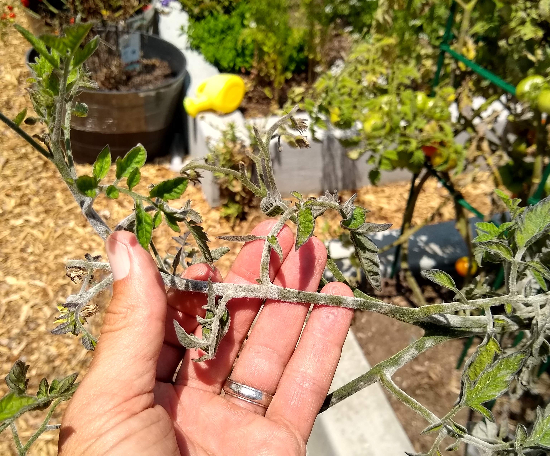
While I was visiting last week I asked Wendy, the garden coordinator, what she advises for powdery mildew. She gave a dry laugh. “Nothing,” she said. “You can’t really beat it in this kind of location with the clouds and the high humidity. You’ve just got to live with it.”
Then we talked about all of the oft-repeated cures for powdery mildew: spraying leaves with milk solutions, spacing plants out for better airflow, removing infected leaves. They can all appear to help, but none eliminate the PM.
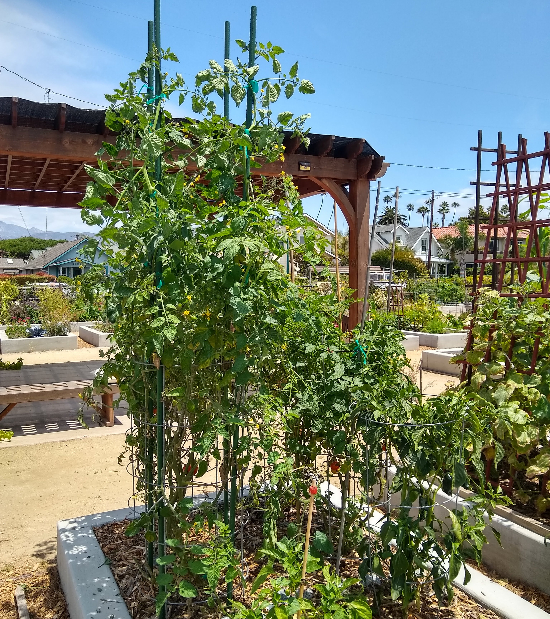
“I’ve been trying to identify a pattern as I walk around, trying to connect plants with the least infection to other things I see in the plots,” I said.
“I’m always looking for patterns too,” she said.
Community gardens are unique opportunities for this. You have dozens of discrete plots of similar vegetables grown by different people in different ways, all in the same location. It’s fertile ground for making comparisons.
Wendy said, “I have noticed some differences in varieties. And I’ve also noticed that people who rush to plant early, like tomatoes in January or February, tend to have it worse. By now their plants look like this.” She picked up a dead tomato vine in a nearby plot.

Wendy also said that she works in multiple school gardens farther and farther inland so she gets to see the reduction of powdery mildew away from the ocean.
“I live far enough inland that I have almost zero powdery mildew,” I told her. “But I have other problems, like sunburn on tomatoes and peppers. I guess it’s a trade off.”
So you can fight powdery mildew but you can’t beat it if the weather conditions are conducive to it. (See this page from the University of California about dealing with PM.)
Pollinators everywhere
Then I switched to a positive topic. “I love how many bees and butterflies you have here in the garden,” I said.
“The coordinator before me, for this first four years of the garden, did a great job designing it and planting all the natives and flowers.”
Almost the entire perimeter of the garden is planted with natives and other flowering plants that feed bees and butterflies. The place feels lively with the various flying insects. I took many photos of them.
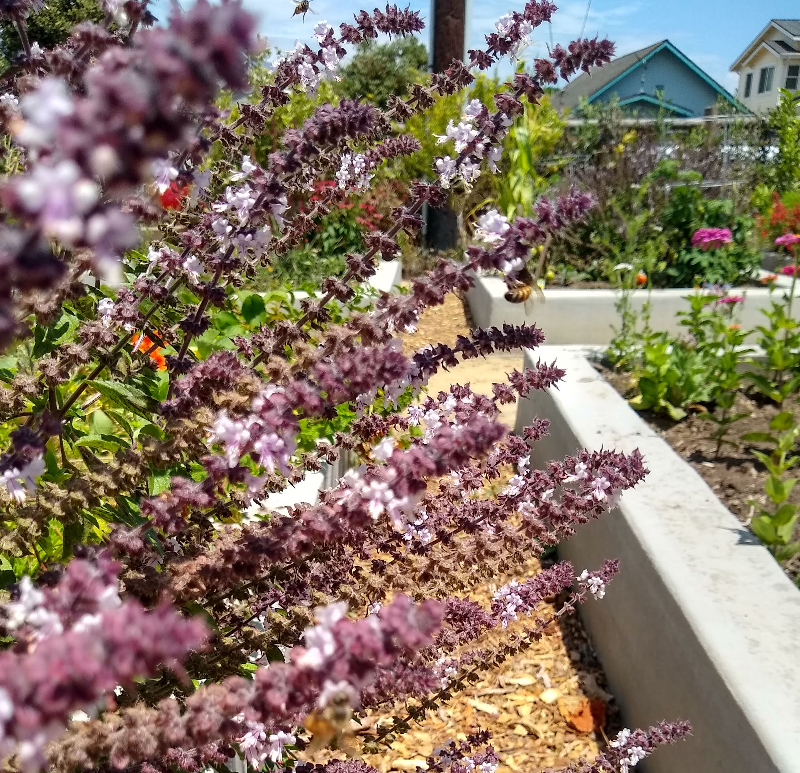
Plant their food and they will come. Before the community garden occupied this parcel of land there were next to no pollinators buzzing around. The community garden brought them. You can do the same in your yard.
(See my post, “Growing a bee garden.”)
Natives and fruit trees don’t mix
“But it does take a lot of work to maintain all of them,” said Wendy of the abundant natives and flowering plants. “And the fruit trees don’t like it.”
“I noticed that. Poor fruit trees.”
Fruit trees are mixed with the natives along the garden’s perimeter. The natives have grown fast and are now very big whereas many of the fruit trees are stunted.
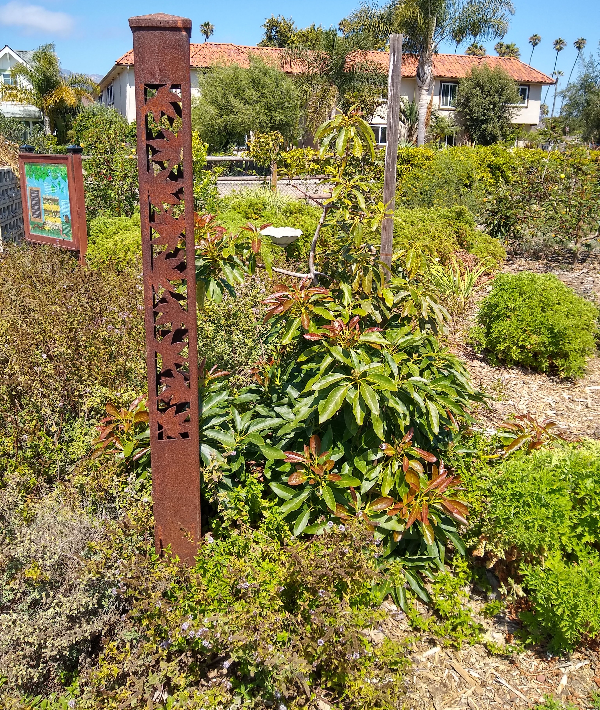

I said, “It looks like the natives are getting more water than they need and are growing really fast, and then they’re stealing even more water from the fruit trees.”
Wendy held up a watering can. “That’s what this is for. I go around giving the fruit trees extra water.”
I’ve seen this relationship in my own yard and in other yards. Native plants and fruit trees don’t mix well. Even though native plants don’t need irrigation, they will take it, voraciously. If you’ve got a native near a fruit tree, you have to give the fruit tree more water than it would need if the native weren’t there because the native will be taking some. This is especially true for wimpy trees like avocados.
Avocados and grapes
But where young avocado trees get a start to life without too much competition in Carpinteria, they grow nearly as well as weeds.
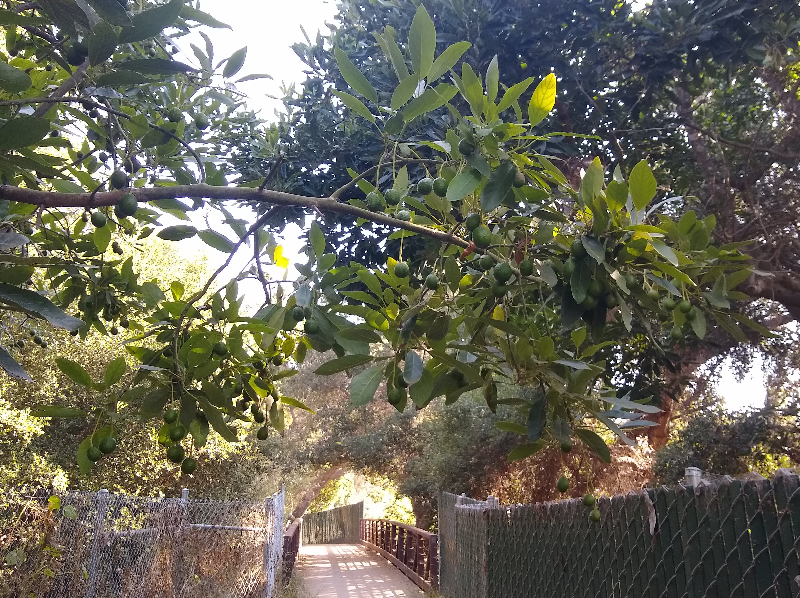
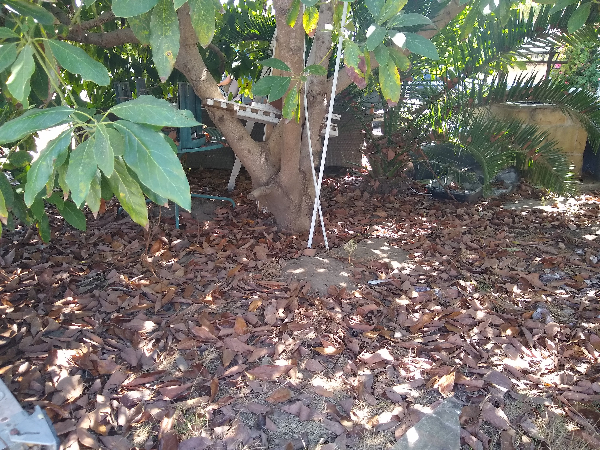
This has everything to do with climate. Avocados love moderate temperatures and high humidity. Carp has both.
On the flip side, grapes don’t grow so well in Carpinteria. There are a handful of grapevines growing over arbors at the community garden. They look just okay and make some fruit.
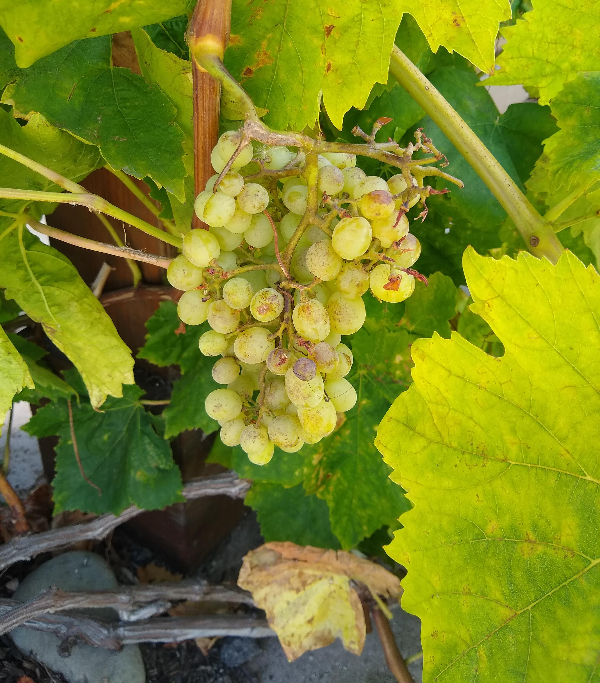
This has everything to do with climate. Grapes love heat and low humidity. Carp has neither.
I have both in my yard. Grapes grow too easily for me.

I wish I loved grapes more and avocados less, considering where I live. I’m sure there is someone who lives in Carpinteria who wishes he loved avocados more and grapes less.
We should all just keep in mind that even within the relatively uniform climate of Southern California, there remains enough variability that certain plants grow like weeds in one corner while in others they need lots of help. This doesn’t even take into account other important factors such as soil differences. Temper your inclination to feel defeated or boast about the performances of plants in your yard; it might not be much of your fault or to your credit.
Summer lettuce
An extraordinary plot of the most beautiful lettuce in the garden reminded me again of this lesson.
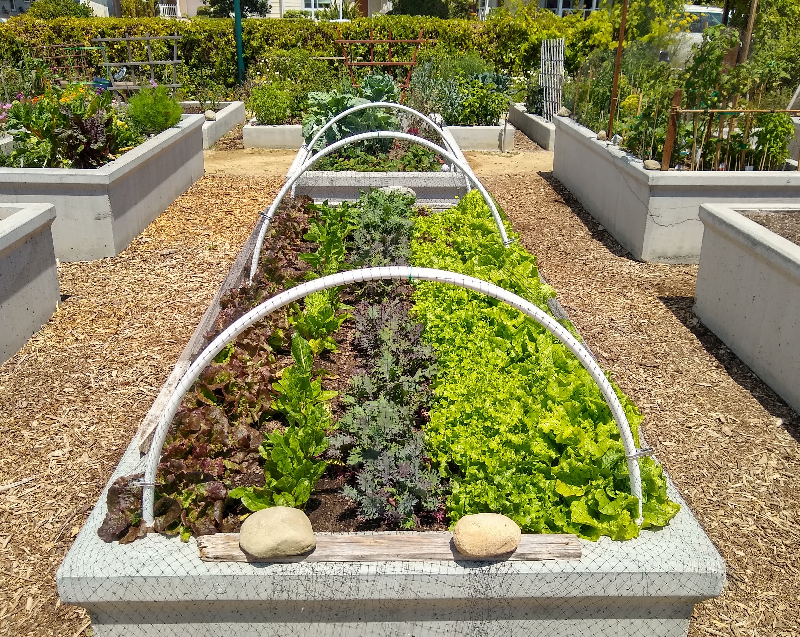
I challenge you to find such a plot in a community garden in one of the Southern California valleys. It’s the beach climate that allows such a perfect plot of lettuce in mid summer.
Yet, the planting calendar . . .
Nevertheless, all locations in Southern California between the ocean and the mountains should plant on nearly the same calendar. There isn’t that much variability.
For example, both at my inland place and at Carp, bulb onions should not be planted in spring or summer. They should be planted in fall or early winter everywhere in Southern California, otherwise they won’t make much of a bulb.
I saw two plots that illustrated this:
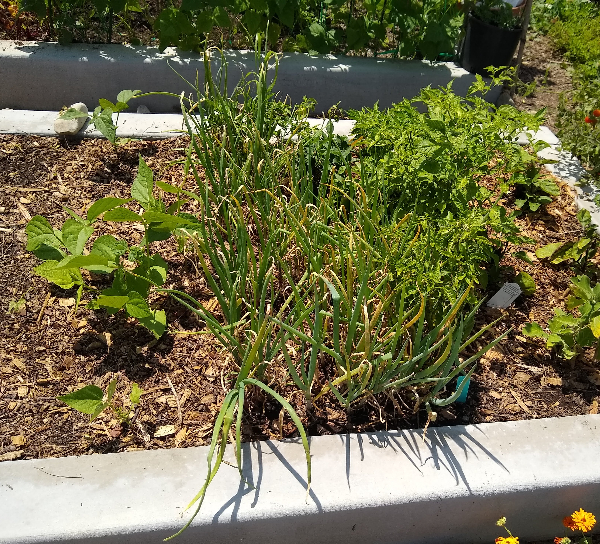
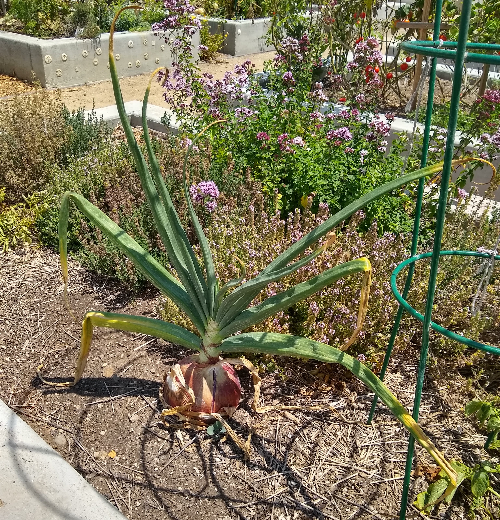
I left Carpinteria on Monday and I’m back inland in the heat now. I have a better appreciation for my grapes and my pluots and my tomatoes that have no powdery mildew. But I’m also missing those relaxing, foggy mornings.
Thanks to your support I get to spend time sharing garden stories and lessons like these ones from the Carp Community Garden. Learn how to support HERE
All of my Yard Posts are listed HERE

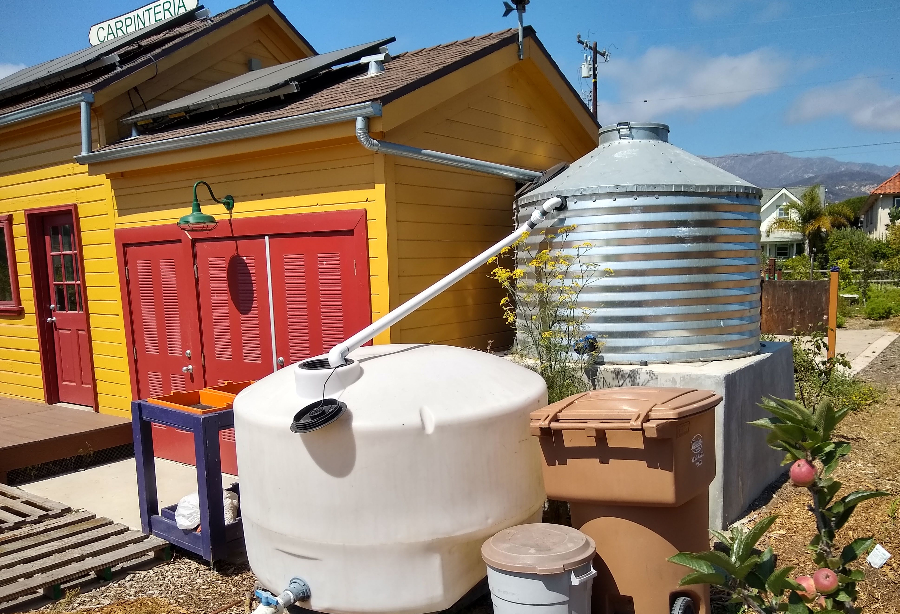


Such a great post! I live near the ocean in Santa Barbara and everything you said rings true. When you’re here next year please come visit and tell me how to grow my garden. I’ll give you all my avocados 😃
Hi MMG,
It’s a deal!
great post thanks, seems similar there to where we are in SD
My grandfather lived in Oxnard and as kids we cousins loved visiting Santa Claus Lane in Carpinteria! That’s what came to mind right away reading your post. Glad to know there are other attractions 🙂 I’m in Sonoma County and while powdery mildew is not our issue inland – tomato season is a bit sad so far with weird swings in morning/evening vs afternoon temps. Great to see the variability of microclimates down south as well.
I believe in your photo regarding bees the african blue basil is pictured. one of my favorite plants.
tom
On the topic of where SoCal ends and NorCal begins, I use baseball as my rule of thumb. If the local news covers the dodgers, you are in SoCal. If they cover the giants, NorCal.
By this (questionable) logic, SoCal reaches all the way up to Cambria / Paso Robles.
I have worked in carp and lived in cambria (not at the same time…). And they share more in common with each other than with any beach town in NorCal!
I like it, Dan. But I have two thoughts to add.
1. What about the Padres?
2. I use surfing as my rule of thumb. Once you get in the ocean above Point Conception, the water is freezing! I can surf as far north as Jalama without booties (technically a stone’s throw above Point Conception), but I cannot handle Morro Bay without wearing them. (Nevermind that I am a sissy when it comes to chilly water.)
My wife grew up in chula vista. There’s no question about what end of California that is….
Morro Bay (which apparently will be hosting an avocado festival this year) is bath tub warm. Try surfing mavericks. True Norcal water is coooold.
I used to visit relatives in Carpinteria every year during summer and at Thanksgiving. My aunt and uncle’s property backed up to a friend’s avocado grove. That’s what started my obsession with growing and eating avocados. Great memories!
Wish I’d known you were in town, because I definitely owe you dinner considering how much great advice I’ve gotten out of your site since I started my pandemic gardening. On the plus side this thought made me find your support page, so I guess it all worked out.
I’m a couple miles inland in Santa Barbara (enough to avoid most fog) and powdery mildew on my tomatoes is a common annoyance most years, but this year I haven’t seen any in my garden at all. Not sure how I lucked into that, but I’m not complaining.
Thanks for the great website.
Great post! I live near the coast (Bay Park) and all methods to fight PM especially on pumpkins and squash send to make it worse. Now I’ll just give up and go with the flow! Thanks Greg!
I just moved a few blocks from the community garden, fingers crossed there’s an open plot I can reserve. I’m pretty new at gardening. Years ago a gopher ate all my hard work, traumatizing. But humbling I guess too? If I get a spot what do you suggest I plant this time of year? Sept/Oct.
Thank you!
Hi Tiffany,
I hope you get a plot soon. In Sep/Oct there, I would start carrots, beets, broccoli, cauliflower, cabbage, lettuce, potatoes.